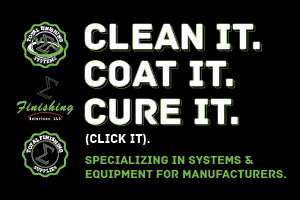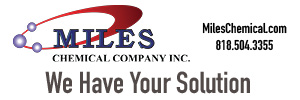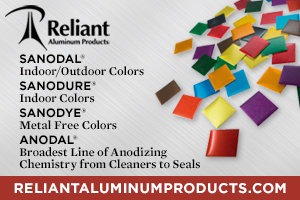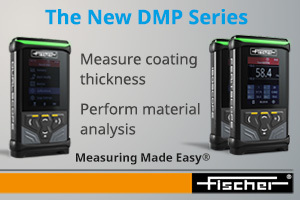The metal-finishing industry serves up fresh challenges daily.
 Stephen Rudy CEFThese are driven by environmental regulations, corrosion requirements, meeting specific designations and specifications, increased quality production, and the demands of various industry users.
Stephen Rudy CEFThese are driven by environmental regulations, corrosion requirements, meeting specific designations and specifications, increased quality production, and the demands of various industry users.
As a result, it’s a team effort to do our jobs: troubleshooting, understanding processes, knowing how to adapt, what to use and what not to, prioritizing, working together, share data and observations. This is not a venture of hit-and-miss.
Duplex Nickel: Serious Corrosion Fighter
Duplex nickel is most effective in achieving the optimum corrosion protection of nickel-plated parts with a flash of chrome (consider automotive applications). The typical dual nickel deposit –a 75% underlayment of semi-bright nickel followed by a 25% topcoat of bright nickel – provides excellent corrosion protection.
Controlled corrosion testing confirmed that corrosion on copper/bright nickel/chromium-plated zinc die-cast parts occurred within 12-18 months in severe testing environments. By substituting an equal thickness of duplex nickel, corrosion was delayed for at least 24 months. Also noteworthy: the ductility of the semi-bright deposit is at least 500% greater than that of the bright deposit. Specifically, details for the application and control of duplex nickel followed by a flash chrome top coat are defined per ASTM B 456.
Total nickel deposit thickness should be a minimum of 0.0005 inches (0.5 mils). The semi-bright nickel deposit must equal or exceed 60% of the total nickel thickness. The sulfur content of the semi-bright nickel must not exceed 0.0005% by weight.
The bright nickel deposit thickness should be less than or equal to 40% of the total nickel deposit thickness. The sulfur content of the bright nickel deposit should exceed 0.03% by weight.
The microporosity of the chrome deposit should be 64,000 pores/inch2.
Duplex nickel deposits are very prevalent in exterior automotive finishes. The following pictures are examples.
Trivalent Chromium Plating: Healthier, Safer, Twice as Efficient
This process employs inert anodes, inorganic trivalent chromium salts, conductivity salts, and complexing agents. Wetting agents and grain refiners. Depending on the proprietary bath commercially used, the plating solutions are typically blue to blue-green in color.
The health and safety hazards associated with hexavalent chromium baths are eliminated. All hexavalent chromium compounds are considered carcinogenic to workers. The risk of developing lung, nasal, and sinus cancer increases with the amount of hexavalent chromium inhaled and the length of time the worker is exposed. Studies of workers in chromate production, chromate pigment, and chrome electroplating industries employed before the 1980s show increased lung cancer mortality rates. These health dangers are why the plating industry has instituted chemical and mechanical safeguards, thus significantly reducing, but not eliminating, these described problems.
Regarding inhalation of Cr (VI) dust, mists, or fumes, the permissible exposure limit is five micrograms per cubic meter of air calculated on an 8-hour time-weighted average. Previously, it was 52 micrograms per cubic meter. Personal protective clothing, approved work conditions, application of PFAS-free fume suppressants and surface tension modifiers, and OSHA-compliant ventilation, along with other safeguards, are in place.
Interestingly, the Food and Drug Board of The National Academy of Sciences established daily recommended dosages of Chromium (from Trivalent sources) for all age groups, male and female. For example, adults require 20-35 micrograms of Chromium each day.
Therefore, commercial, decorative trivalent chromium plating has greatly benefited the plating industry and met health and safety regulations.
Just the aesthetic differences in pictures comparing both plating baths provide a stark difference in appearance, benefiting the trivalent chromium bath.
Reducing trivalent chromium to the metallic state requires three electrons versus the same reaction that requires six electrons for the hexavalent chromium ion. Therefore, the trivalent chromium bath is at least twice as efficient as the hexavalent bath (approximately 25-30% compared to approximately 10-15%).
Cr+6 + 6 electrons = Cr metal Cr+3 = 3 electrons = Cr metal
The rectification demand is thus reduced. Trivalent chromium baths tolerate 5% AC ripple (which is similar to nickel). Current interruption does not result in plated deposit whitewash as in hexavalent-based baths. Two types of decorative trivalent chrome baths are in commercial use. One uses carbon an-odes in a chloride-based electrolyte. The other uses an alloy of platinum elements on an inert core in a sulfate-based electrolyte. Both types of baths require a source of Chromium III inorganic salts, a grain refiner, a buffer, and a wetting agent.
Trivalent baths support larger surface areas per flight bar (more parts) for decorative plating applications, giving greater production throughput. In some production installations, the limiting factor to parts loading on flight bars is a factor of the preceding nickel plating bath. Trivalent chromium deposits may be slightly darker when compared to hexavalent deposits. However, refinements in process chemistry have improved color comparison, such as combining hexavalent and trivalent chromium plating fixtures. This may factor in incorporating organic agents in the deposit and modifying the crystal structure.
Note: Trivalent chrome baths deposit the metal to a limiting thickness of approximately 20 millionths of an inch. Some recent developments do claim to achieve a greater deposit thickness. There is a point in the deposition process where the thickness becomes self-limiting, unlike the hexavalent bath, which will keep building in thickness. By comparison, the decorative deposit thickness of hexavalent chromium-based deposits is 5-50 millionth inch. This is a driving force to improve chrome deposit thickness (>0.001”) to replace hard chrome, which is under development, with some or limited industrial applications.
Another industry-challenging project has been working to develop a production barrel decorative trivalent chromium plating process.
Similarly, trivalent solutions will not passivate unplated steel surfaces (such as the inside of tubes). Therefore, chrome-free passivating post-dips may be required.
Nasty Oils: Getting Them Out
Certain oils can be exceedingly difficult to remove in the soak cleaner, especial-ly if they adversely affect the finishing cycle. Chlorinated and paraffin oils can literally gum up on parts especially when using caustic (sodium or potassium hydroxide) cleaners. Better cleaning results can be obtained with non-caustic, alkaline cleaners that are silicate-based, containing specific ratios of nonionic to anionic surfactants.
Molybdenum-sulfide lubricating grease can also be a tough material to clean off. The soak cleaner type described above may also work best here.
Mineral, spindle, and water-soluble oils may best be removed in a soak cleaner that contains approximately 25% caustic and silicates, in addition to the described surfactants, with additional dispersing agents. Post-cleaning observations and appropriate testing should lend sufficient decision support to your ultimate choice of soak cleaner.
Rust Spots in Electrocleaning
How often have you noticed steel parts exiting the electrocleaner with a brown, stained appearance? Or worse yet, brown splotches and even high-current density burning? It happens in rack and barrel. Chances are that it’s the wrong electrocleaner formulation or maybe the right one that happens to be under-concentrated. Lack of reserve alkalinity in the bath will prevent the iron hydroxide film that forms on the surface from being dissolved during anodic conditions. This reserve alkalinity is referred to as caustic soda. Even less caustic results in poor conductivity that tends to etch and burn the high-current density. Adjust the operating electro-cleaner concentration or switch to an appropriate concentrate blend.
Corrosion Spots after Electrocleaning
Another challenge in rack-and-barrel systems is that parts exiting the bath have black dot spots—corrosion spots. This problem is typically found in double-cleaning cycles or where racks or barrels cross between the acid and electro-cleaner. Drag-in of the first hydrochloric acid solution into the second electro-cleaner introduces chloride as a contaminant. During anodic treatment, chloride is attracted to the part, forming chlorine gas bubbles (oxidation product). The bubbles remain in place long enough to etch the steel.
Corrective measures include switching the acid from hydrochloric to a suitable alternative, such as sulfuric acid; better rinsing between the acid and electro-cleaner; or switching to a sufficiently inhibited electro-cleaner formulation to prevent corrosive etching on steel.
Did You Know? How is Aluminum … Aluminum?
We associate this metal with its superior strength - close to steel but roughly half its weight. Yet it is still soft and pliable.
Questions: How does it come by all these properties? And what does it mean for us going forward?
The following tables describe aluminum designations of aluminum alloys and their typical industrial applications.
The first digit is the principle aluminum alloy. The first digit also describes the aluminum series. Ksi is ultimate tensile strength range.
| 1XXX | Min 99% Aluminum | 10 - 27 ksi |
| 2XXX | Copper | 27 - 62 ksi |
| 3XXX | Manganese | 16 - 41 ksi |
| 4XXX | Silicon | 25 - 55 ksi |
| 5XXX | Magnesium | 18 - 51 ksi |
| 6XXX | Magnesium and Silicon | 18 - 58 ksi |
| 7XXX | Zinc | 32 - 88 ksi |
| 8XXX | Other Elements | - |
| Alloy series | Alloy | Properties | Applications |
| 1xxx | Pure | Low strength; excellent thermal/electrical conduction; and corrosion resistance; highly reflective. | Fuel filters; electrical conductors; radiator tubing; lighting reflectors; decorative components. |
| 2xxx | Cu | High strength; relatively low corrosion resistance; good elevated temperature strength. | Aircraft skin; aircraft fittings and wheels; ballistic armour; forged and machined components. |
| 3xxx | Mn | Medium strength; good formability; good corrosion resistance. | Storage tanks; beverage tanks; home appliances; heat exchangers; pressure vessels; siding; gutters. |
| 4xxx | Si | High castability; high machinability; high fluidity; low ductility. | Variety of castings; including large castings; filler metals (2xxx; 3xxx; 5xxx and 7xxx used for castings). |
| 5xxx | Mg | Medium strength; good formability; excellent marine corrosion resistance. | Interior automotive; appliance trim; pressure vessels; armour plate; marine and cryogenic components. |
| 6xxx | Mg; Si | Med-high strength; good corrosion resistance; easily extruded. | Exterior automotive; automotive profiles; railcars; piping; marine; screws stock; doors; and windows. |
| 7xxx | Zn | Very high strength; prone to stress corrosion; poor corrosion resistance. | Aircraft construction; truck trailers; railcars; armour plate; ski poles; tennis rackets. |
| 8xxx | Li | Very high strength; low density. | Aircraft and aerospace structures; foil; heat exchanger fin stock. |
As we all know, raw aluminum is alloyed with metals such as magnesium and silicon. The product is then baked, transforming the alloy into a strong, durable material. However, until recently, it was not understood how the alloy structure forms and promotes high strength.
First, the element silicon forms a pillar and skeleton assembly. In this assembly, particles of an inorganic complex consisting of magnesium, silicon, and aluminum are formed. This critical structure then forms an additional inorganic species made of magnesium/silicon. This formation inhibits the tendency for aluminum to behave as a smooth metal. Now that this heating and annealing process is more understood, even stronger and more workable aluminum alloys may be formed. This can lead to many benefits, including reducing the weight of motor vehicles to yield better gas mileage.
The more you know, the better your metal finishing operation will be.
Stephen F. Rudy, CEF, is president of Chem Analytic and has written extensively about the finishing industry. Visit www.chemanalytic.com or call him at 917-604-5001.



































